Dietary fats are a public health concern
- Dietary fats are necessary for ensuring optimal health. Recent dietary guidelines focus on fat quality and advise including appropriate amounts of polyunsaturated fatty acids (PUFA), such as omega-3 and omega-6 while restricting saturated and trans fatty acids.
- Diets that have high levels of saturated or trans fatty acids are associated with increased risk of diseases such as cardiovascular disease, metabolic syndrome and type 2 diabetes.

Dietary fats are necessary for ensuring optimal health
- Some foods are sources of fat soluble vitamins A, D, E, and K.
- Some foods are sources of essential fatty acids (EFA)
- There are 2 primary EFA:
- linoleic acid (omega-6)
- alpha-linolenic acid (omega-3)
- EFA cannot be made by the body and are strictly required from the diet:
- for the structure of cell membranes and growth of all body tissues
- as precursors of hormone-like molecules called eicosanoids which help maintain many normal body functions (e.g. blood clotting, inflammatory reactions)
- There are 2 primary EFA:
- Dietary fats are a source of energy for the body.

Different types and sources of fat
Some foods contain more saturated fats (SFA) while others are good sources of polyunsaturated fatty acids (PUFA)
- Fats are made of fatty acids, which are carbon chains of different lengths “covered” with hydrogen atoms.

Figure 1. Types of fatty acids
Fatty acids can be classified into:
- Saturated fatty acids (SFA) – these have no double bonds along the carbon chain and have good oxidative stability in foods.
− Sources: red meat, full-fat dairy, palm oil and coconut oil
- Monounsaturated fatty acids (MUFA) – these contain only one double bond.
− Sources: avocados, sesame oil, high oleic seed oils and olive oil
- Polyunsaturated fatty acids (PUFA) – these contain 2 or more double bonds and have lower oxidative stability in foods.
− Sources of Omega-6: sunflower, soybean and corn oils
− Sources of Omega-3: soybeans and rapeseed seeds and oils, walnuts, almonds and seafood
Higher total dietary fat intake does not necessarily lead to higher body weight gain
- Fats provide 9 kcal/g while proteins and carbohydrates provide 4 kcal/g each, therefore previously higher fat intake was thought to be associated with body weight gain.
- An increase in body weight results when more energy is consumed than the body uses and the extra energy gets stored regardless of the food source.
- A recent study by Estruch and colleagues (2016) showed that over several years a high vegetable fat Mediterranean diet, enriched in olive oil or nuts, with no calorie restriction, did not lead to higher weight gain than a diet where people were advised to reduce dietary fats1. These results support advice of not restricting intake of healthy fats for bodyweight maintenance.
- A recent study by Estruch and colleagues (2016) showed that over several years a high vegetable fat Mediterranean diet, enriched in olive oil or nuts, with no calorie restriction, did not lead to higher weight gain than a diet where people were advised to reduce dietary fats1. These results support advice of not restricting intake of healthy fats for bodyweight maintenance.
- Overall, it is recommended by the Food and Agriculture Organization (FAO) & World Health Organization (WHO) to maintain appropriate dietary patterns, energy levels and adequate physical activity levels for preventing unhealthy weight gain.
Dietary fat and cardiovascular health:
a. Does saturated fat consumption increase blood lipids?
Consuming high levels of SFA (vs. MUFA and PUFA) can lead to an increase in the level of low-density lipoprotein- cholesterol (LDL-C) in the blood. Having high levels of blood lipids, including LDL-C and triglycerides, is a risk factor for cardiovascular diseases (CVD). However, not all SFA behave the same as there is no evidence to suggest that short chain SFA found in dairy products; and stearic acid, a SFA found in cocoa butter, raise the levels of blood LDL-C. In many trials, reducing SFA intake by replacing it with PUFA and/ or MUFA was found to be more favorable for reducing blood LDL-C than replacing SFA with carbohydrates2. Therefore, to decrease blood lipids, it is not enough to just decrease SFA consumption but it is important to know what to replace it with.
b. Does saturated fat consumption increase the risk of cardiovascular disease?
From observational studies there is no evidence of association between total SFA intake and CVD risk (path 1 of diagram). However interventional studies where SFA were decreased and replaced with PUFA found a small reduction in risk3. Once again, it is not enough to just decrease SFA consumption but it is important to know what to replace it with.
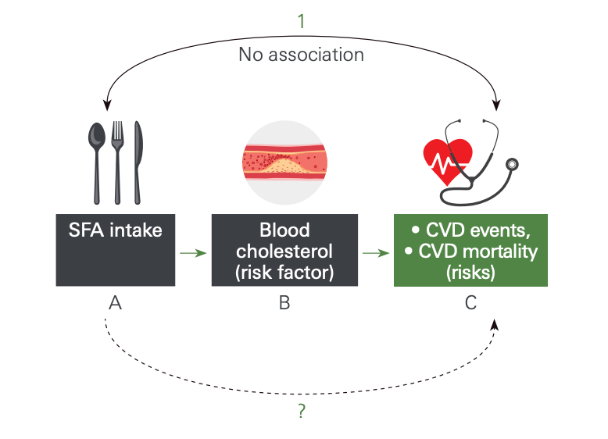
Figure 2. Saturated fatty acids and cardiovascular diseases
Benefits of consuming unsaturated fatty acids
- Linoleic and alpha-linolenic acids (essential fatty acids or EFA), are needed for normal growth and development of children; they also contribute to the maintenance of normal blood cholesterol levels.
- Walnuts, which contain the two EFAs, contribute to the improvement of the elasticity of the blood vessels; this benefit is seen when at least 30g of walnuts are consumed per day.
- Docosahexaenoic acid (DHA) and eicosapentaenoic acid (EPA) contribute to the maintenance of normal blood triglyceride levels, normal blood pressure and normal function of the heart.
- DHA contributes to the maintenance of normal visual and brain function.
- Maternal intake of DHA contributes to the normal development of the eye and brain of the fetus and breastfed infants.

Cholesterol
- The body is able to synthesize cholesterol so it is not required in the diet.
- Cholesterol’s role is to keep the fluidity of cell membranes and help to produce some hormones and vitamin D.
- Most dietary cholesterol comes from foods which are also significant sources of dietary SFA (e.g. meat products).
- Many health authorities have withdrawn their recommendations to limit dietary cholesterol and instead recommend limiting SFA intake (less than 10% total daily energy intake)4.

The special case of trans fats
- As a consequence of their chemical configuration, trans fats behave more like saturated fats and are solid at room temperature.
- Partially hydrogenated vegetable oils (PHO) were popular food ingredients because of their high content of trans fats which provided the structure of solid fats without the SFA.
- However, it was found later that trans fats do, in fact, raise the levels of LDL-C (“bad” cholesterol), decrease the levels of HDL (“good cholesterol”) and increase CVD risk.
- In 2015, the US Food and Drug Agency announced the decision to withdraw the GRAS status for PHO for any use in human food meaning that they were not considered safe for consumption. As a result, most food manufacturers have eliminated them from products.
- Trans fatty acids are also formed in the rumen of ruminants and are naturally found in milk, beef or lamb, in small amounts.
- Currently, the average trans fat consumption in most countries is below the limit of 1% of energy set by the FAO/ WHO (2010).
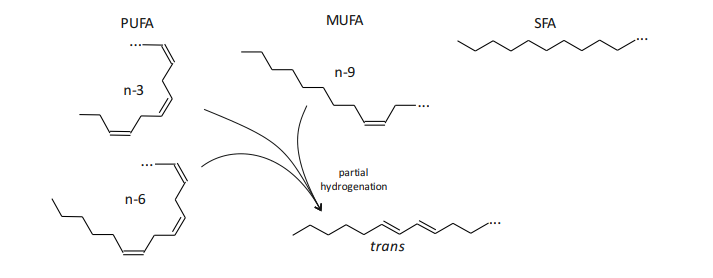
Figure 3. Structures of fatty acids
Dietary fat recommended amounts
- FAO/ WHO recommend total fat intake between 20-35% of total daily energy intake (%E) in adults and 25-35% in children5.
− For example: this corresponds to 44-78 g per day for young women (based on total daily intake of 2000 kcal and a conversion factor of 9 kcal/g fat).
- Total fat intakes differ worldwide and children appear to be the most at risk of excess fat intake. For example:
− In the U.S., Australia, New Zealand, South America, and South Africa, the total fat intake in children is on average in the recommended range. However, on an individual basis, many children exceed the recommendations. In some European countries, children exceed recommended levels as an average.
− In the UK and North America, the mean intake for adults is ~33%E – close to the recommended upper limit.
− In some European and African countries (e.g. Belgium, Germany, Greece, Ireland, Latvia, Lithuania, Romania, Spain, Cameroon and Nigeria) mean intakes exceed 40%E.
− In some countries in Asia and Africa, intakes are generally below recommendations for children and adults. In the Philippines, majority of the population have fat intake below the acceptable macronutrient distribution range, especially among children, elderly and lactating mothers6.

The total fat content of typical food servings
Table 1. Sources of fat and their contents in a typical serving
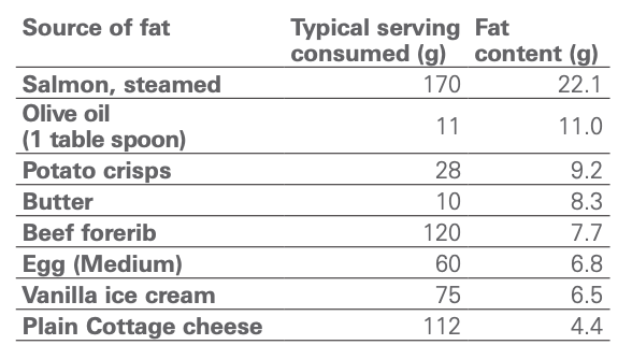
It is important to not just look at total fat content, but rather at which types of fats foods contain. For example, salmon is a good source of omega-3.

Dietary fats we should consume
Many people worldwide should consume more seafood omega-3.
Table 2. Daily intakes and recommendations of fatty acids
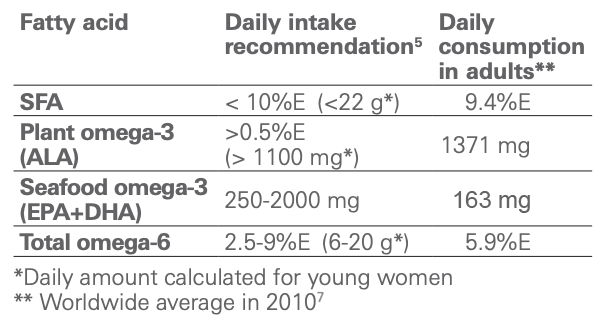
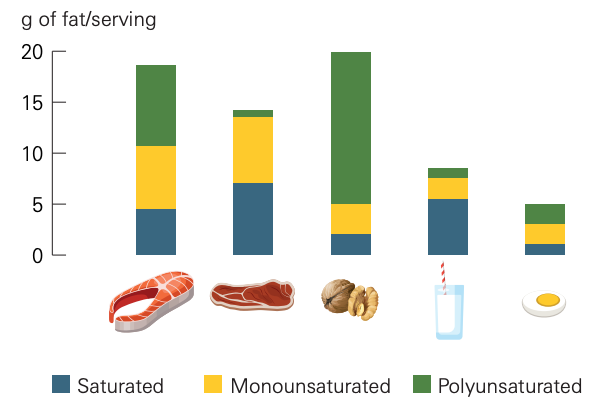
Figure 4. Fatty acid content of common fat sources
The best culinary oils
- Use plant oils which are high in MUFA and PUFA such as sunflower oil, corn oil, and safflower oil. These oils are also best suited for frying.
- Coconut oil is suitable for cooking because of its high smoke point (205oC) with high stability after heating. It also contains medium chain triglycerides, which is associated with increased high density lipoprotein or good cholesterol8-9.
- Avoid excessive amounts of animals fats such as butter, lard, tallow, and shortenings as these contain high levels of saturated and trans fatty acids.
- Oils such as linseed oil and walnut are less stable. These oxidize under ambient conditions and decompose when heated, causing off-flavors. Extra virgin olive oil is more stable under ambient conditions and can be used for single-time frying. These oils can be used for dressing salads or sautéing where little or no heat is required but not for deep frying with high temperatures10.
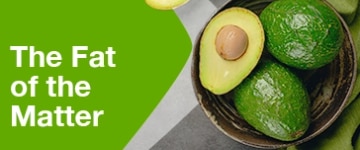

 Nestlé
Nestlé















No comments here yet.